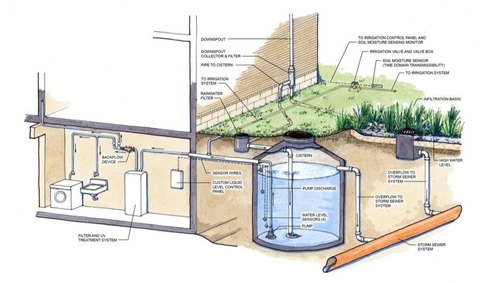Broadly there are two ways of the water harvesting, namely Surface Runoff harvesting and Rooftop Rainwater Harvesting. Rainwater harvesting is the collection and storage of rain for reuse, instead of allowing it to runoff.
Methods of Rainwater Harvesting
Surface Runoff Harvesting:
In urban areas, rainwater flows away as surface runoff. This runoff can be caught and used for recharging acquirers by adopting appropriate methods.
Rooftop Rainwater Harvesting:
In this system rainwater is catch from where it falls itself. Roof becomes the catchment in this type of system and water is collected from the roof of the house/building. This method is less expensive and very useful, which helps in the augmenting the groundwater level of the area.
Components of Rooftop Rainwater Harvesting:
Catchment:
Surface receiving the rainfall directly is the catchment of rainwater harvesting system. It can be terrace, courtyard, or paved or unpaved open ground.
The terrace may be a flat RCC/stone roof or sloping roof. Therefore, the catchment is the area, which actually contributes rainwater to the harvesting system.
Transportation:
Rainwater from the rooftop should be carried own through the water pipes or drains to the storage/harvesting system. UV resisted (ISI HDPE/PVC pipes) of the required capacity is suggested to use.
The water collected from the sloping roof should be caught through gutters. The mouth of the drains should be closed with the mesh, to restrict the floating material.
First Flush:
First Flush is a device used to flush off the water received in the first shower. The first Shower of rainwater needs to be flushed-off to avoid storage of contaminated water due to the atmosphere and catchment roof.
It also helps in the cleaning of the silt and other material deposit on the roof during the summer season. Provisions of first rain separators should be made at the outlet of each drainpipe.
Filter:
There is always some incredulity regarding the roof top rainwater harvesting since doubts are raised that rainwater may contaminate groundwater. This fear can come true if proper filter mechanism is not adopted.
All care must be taken to see that underground sewer drains are not punctured, and no leakage is taking place in close vicinity. Filters are used for treatment of rainwater effectively by removing turbidity, color, and microorganisms. After the first flushing the rainwater should pass through filters.
‘Netlon’, gravel, sand and screen filters are designed and placed on the top of the storage tank. This filter is very important to keep the rainwater in the storage tank clean. It removes sediment, dust, leaves and other organic matter, which will eventually be stored in tank.
The filter media should be cleaned daily after every rainfall event. Clogged filters prevent rainwater from easily entering the storage tank and the filter may overflow. The sand or gravel media should be taken out and washed before it is replaced in the filter.
There are different types of filters in practice, but the basic function is to purify water.
Sand Gravel Filter:
These are common filters made of masonry, filled with pebbles, gravel and sand. Each layer should be separated by wire mesh.
Charcoal Filter:
Carbon filters can be made locally or in barrels. The pebbles, gravel, sand and charcoal should fill in the bucket or combustion chamber. Each layer should be separated by wire mesh. A thin layer of charcoal is used to absorb the smell if any.
PVC – Pipe Filter:
This filter can be made by PVC pipe of 1 to 1.20 m length; Diameter of pipe depends on the area of roof. Six inches dia. pipe is enough for a 1500 Sq. Ft. roof and 8 inches dia. pipe should be used for roofs more than 1500 Sq. Ft. Pipe is divided into three compartments by wire mesh.
Each component should be filled with gravel and sand alternatively. A layer of charcoal could also be inserted between two layers. Both ends of the filter should have a reduction of the required size to connect the inlet and outlet. This filter could be placed horizontally or vertically in the system.
Sponge Filter:
It is a simple filter made from PVC drum having a layer of sponge in the middle of drum. It is the earliest and cheapest form filter, suitable for residential units.


